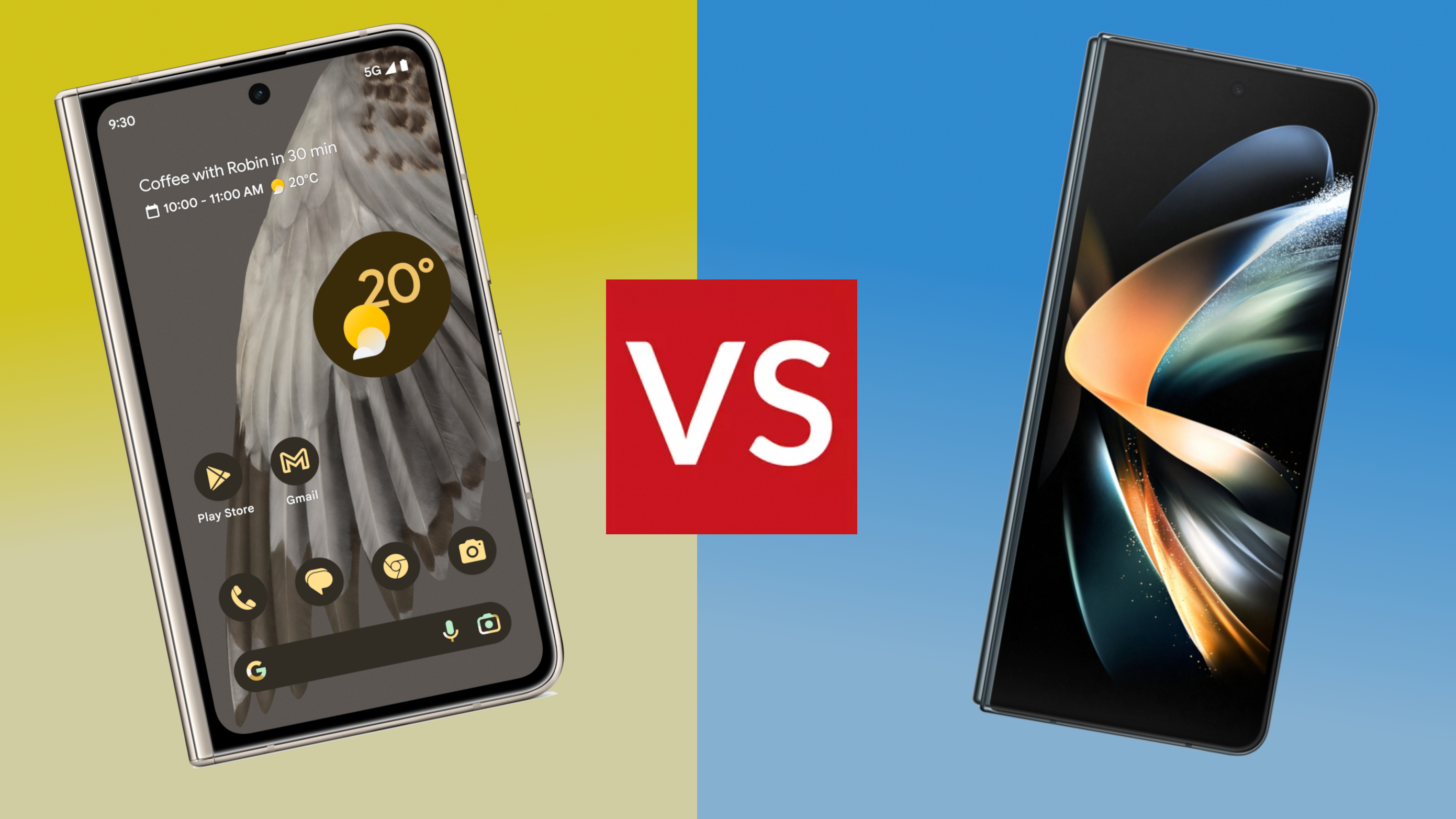Google Pixel Fold vs Samsung Galaxy Z Fold 4: which is the best foldable phone?
The Google Pixel Fold is here, and could tempt you away from Samsung Galaxy foldable phones

The Google Pixel Fold has just been unveiled, with its sights set firmly on the title of best foldable phone. The Samsung Galaxy Z Fold 4 is the reigning champion in that arena, and offers a compelling package.
But is it enough to keep out the competition? Let's dive in and find out.
Google Pixel Fold vs Samsung Galaxy Z Fold 4: Price
If you aren't familiar with foldable phone pricing, brace yourself. These handsets are the most premium on the market and carry a price tag to match.
The new Google Pixel Fold starts from £1,749 in the UK. That bags you 12GB of RAM and 256GB of storage, with an option to upgrade to 512GB of storage also on offer.
That's £100 more expensive than the Samsung Galaxy Z Fold 4, which starts at £1,649 for the same specs, and offers options for 512GB and 1TB. That's a tough start for the Pixel Fold. Coming into the market more expensive than anything else of note isn't ideal, and this handset is going to need to mean business if it's to be justified.
Google Pixel Fold vs Samsung Galaxy Z Fold 4: Display
Display technology is naturally at the heart of a good foldable handset, so big things are to be expected. Let's start with the cover display.
The Pixel Fold packs a 5.8-inch screen onto the front, with a 2092 x 1080 resolution. That's smaller than the Z Fold 4, which boasts a 6.2-inch cover display with a 2316 x 904 resolution. It's close enough that it shouldn't make much difference, though. Those specs are slightly skewed, too, as the Samsung uses a longer and thinner screen, where the Pixel Fold is more akin to a traditional slab phone.
Get all the latest news, reviews, deals and buying guides on gorgeous tech, home and active products from the T3 experts
Inside, the Pixel Fold packs a 7.6-inch display. That uses a 6:5 aspect ratio, with a 2208 x 1840 resolution. This one is more directly comparable to the Fold, and pips it to the post. The Z Fold 4 also has a 7.6-inch, 6:5 display, with a 2176 x 1812 resolution. It's close enough that you likely won't notice a difference in regular use.
Both screens on both handsets are OLED panels, and they all feature a 120Hz adaptive refresh rate. Realistically, there's not going to be too much to pick apart here – whichever model you opt for, you're getting a top spec display inside and out. The different cover display size might swing a few more buyers, though, with the Pixel Fold feeling much more familiar by comparison.
Google Pixel Fold vs Samsung Galaxy Z Fold 4: Design
In terms of design, there's not a great deal to separate the two. In fact, which you like most is more likely to come down to your personal preference as opposed to any distinct design cues.
The Pixel Fold takes its design from their traditional handsets like the Google Pixel 7 Pro, albeit with the camera bar shortened into a module which doesn't extend to either end of the case like those phones. Similarly, the Samsung will look familiar to fans of the Samsung Galaxy S23, with three camera cut-outs on the back of a relatively plain case design.
One area where the Samsung does beat the Pixel Fold is the bezels on the internal screen. The Pixel Fold sports some especially thick top and bottom bezels which can't help but look slightly out of place on a top-tier handset.
For that reason alone, I think the Samsung has the edge here. Sure, the case design of the Pixel is more interesting overall to me, but those bezels are just so unsightly, it undoes all the hard work elsewhere.
Google Pixel Fold vs Samsung Galaxy Z Fold 4: Cameras
Samsung has a long history of strong camera performance. Slab phones like the Samsung Galaxy S23 Ultra pack in some seriously impressive shot-snapping capabilities.
That isn't quite replicated on the Z Fold 4, though. A rear trio of 50MP, 12MP and 10MP sensors is used here, with 3x optical zoom. That's not a bad showing, but it's some way short of the impressive units packed into more traditional Samsung phones.
The Pixel Fold, then, might just beat the Samsung in its own backyard. The main rear sensor is the 48MP Quad Beyer sensor from the Pixel 7 Pro. That is a seriously impressive camera, which is capable of stunning shots.
That's accompanied by a 10.8MP ultrawide sensor and a 10.8MP telephoto lens, offering up to 5x optical zoom, and 20x Super Res Zoom. That produces a stunning level of detail and clarity, going far beyond the grainy digital zoom images many will think of.
On paper, then, the Pixel Fold looks set to wipe the floor with the Z Fold 4 here. It's quite a core area for most users too, so it should win Google some favour.
Google Pixel Fold vs Samsung Galaxy Z Fold 4: Hardware
Powering the Z Fold 4 is the slightly older Snapdragon 8+ Gen 1. That's a tried and true chipset, with enough power to muscle through a day of scrolling, surfing and working with ease. That's powered by a 4,400mAh battery, which Samsung rate for 16 hours of use.
The Pixel Fold, by comparison, uses their in-house Tensor G2 chip. That's a strong contender, too. It may not look as good on paper, but it delivers where it counts, with a strong AI engine and good levels of efficiency.
The Pixel Fold does pack a slightly larger battery, too. They rate that for more than 24 hours of normal use, and up to 72 hours with the Extreme Battery Saver enabled.
Both run an Android operating system, though the Pixel will sport Google's native version of Android. The Samsung will run the same operating system, but with their One UI overlay on top.
Google Pixel Fold vs Samsung Galaxy Z Fold 4: Which wins?
This is a tough call. The Google Pixel Fold does deliver in some key areas to really justify its price tag. But there are also a couple of areas where it just doesn't cut it. Those bezels are a real eyesore, for example. On a cheap phone, you might let it slide, but at the best part of £2,000, that's not good enough.
The make-or-break for most users will be how well it performs in day-to-day operation. If that Tensor G2 chipset can keep pace and perform well, offering the battery life Google claims is possible, I think it just about edges it for me.
That shouldn't detract from how strong the Samsung Galaxy Z Fold 4 is though. If you aren't concerned about camera performance being as good as possible, that offers a lot of bang for the buck. It's also a tried and true product, with multiple iterations that have refined the formula.

Sam is an award-winning journalist with over six years of experience across print and digital media. As T3’s Senior Staff Writer, Sam covers everything from new phones and EVs to luxury watches and fragrances. Working across a range of different social media platforms alongside his written work, Sam is a familiar face for fans of T3. When he’s not reviewing snazzy products or hunting for stellar deals, Sam enjoys football, analog photography and writing music.
